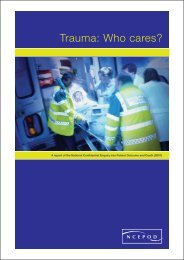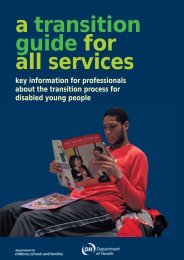(CAMHS) and Schools - London Health Programmes
(CAMHS) and Schools - London Health Programmes
(CAMHS) and Schools - London Health Programmes
Create successful ePaper yourself
Turn your PDF publications into a flip-book with our unique Google optimized e-Paper software.
has been evaluated elsewhere as effective in groups <strong>and</strong> is currently being evaluated<br />
in classroom settings. The programme covers how to behave in the classroom,<br />
listening <strong>and</strong> paying attention, problem solving, anger management <strong>and</strong> making<br />
friendships. The aim is that the whole class, <strong>and</strong> eventually the whole school, can<br />
share a language where problem solving can occur. The course is run over six<br />
months at two sessions per week for 45 minutes per class.<br />
4.2.4 Evaluation <strong>and</strong> Outcomes<br />
The principles behind assessing the effectiveness of the service delivery is to adopt a<br />
comprehensive outcome model to take account of clinical outcomes but also<br />
ecological, consumer <strong>and</strong> economic <strong>and</strong> needs related outcomes. Thus a number of<br />
different approaches to evaluation are being taken. The direct client work of the<br />
Community Child <strong>and</strong> Family Service (CCFS) which includes work in school setting,<br />
is being evaluated to assess who is using the service, what kind of treatment they<br />
received, outcomes in terms of the changes in severity of child mental health<br />
problems <strong>and</strong> parental stress <strong>and</strong> to assess client’s expectations <strong>and</strong> assessments of the<br />
service. This includes both parents <strong>and</strong> adolescents. Service evaluation packs made<br />
up of st<strong>and</strong>ardised measures <strong>and</strong> questionnaires are used to collect information from<br />
children, parents <strong>and</strong> teachers before, <strong>and</strong> four months after the intervention, <strong>and</strong> a<br />
year after for a sub sample (Attride-Stirling et al, 2001). Unfortunately it is not<br />
possible at this stage to disaggregate the figures for the children seen in school<br />
settings. The overall service clinical outcomes (including work not in schools) were<br />
very positive, showing clear improvements in child problems <strong>and</strong> parental coping<br />
after the intervention <strong>and</strong> that the improvements were enduring over a year after the<br />
intervention. Parents reported high satisfaction with the service, especially with the<br />
location of their appointment (the majority within 30 minutes walk from home).<br />
Interestingly, teachers reported less positive change in children’s behaviour than<br />
clinicians or parents <strong>and</strong> adolescents themselves.<br />
The support of the Tier 2 services to Tier 1 services <strong>and</strong> multi-agency approaches<br />
were evaluated to identify whether the introduction of a Tier 2 service affected the<br />
perceived quality of <strong>CAMHS</strong> in terms of service access, working relationships <strong>and</strong><br />
satisfaction (Day et al, in press) with Tier 1 workers (which include GPs, nurses,<br />
health visitors, head teachers, deputy heads <strong>and</strong> SENCOs. The findings were that<br />
there had been improvement in the knowledge, access <strong>and</strong> quality of working<br />
relationships with <strong>CAMHS</strong>. This was stronger when there had been direct contact<br />
with <strong>CAMHS</strong> Tier 2 staff, for example, when referrals had been made.<br />
4.2.5 Feed back from interviewees on impact<br />
The staff providing the service identified positive outcomes of both the Kaleidoscope<br />
project <strong>and</strong> the ‘Dinosaur School’ in terms of the peer relationships, academic<br />
attainment, behaviour <strong>and</strong> exclusion; one felt that she could really see a difference<br />
even just over the eight months of her work. <strong>CAMHS</strong> staff identified that it was more<br />
difficult to work in secondary schools (see discussion in section 5.4.5).<br />
The primary school staff were very positive about the project. The difficulties<br />
reflected working with secondary schools, outlined above, were reflected in the

















